|
< Earlier Kibitzing · PAGE 2 OF 2 ·
Later Kibitzing> |
May-27-16
 | | Penguincw: Right on <Penguincw>. Definitely a long game (I was surprised to see that the puzzle solution started with move 135).. But anyway, I knew that one of black's goals is to get the knight to f2 while white is not guarding it, so the first move I came up with was 135...Kf1, trying to restrict white. Unfortunately, I overlooked 136.Nxf4 (stalemate threat). If 136.Ng5, then 136...Nc5, I guess. Knight endings are tricky (well, aren't all endings tricky), but unlike bishop, rook and queen endings, you rarely have a tempo to give. |
|
| May-27-16 | | dumbgai: <The finish would be 140... Nd1 141. f4 Ne3 142. f5 Ng4 143. f6 g2#> Good find. I would have played 141...Nf2+ 142. Nxf2 and then either g2+ or Kxf2 or even gxf2, all of which easily win but don't mate immediately. |
|
| May-27-16 | | Razgriz: End game puzzles are always something to look forward to. Must have been mentally exhausting to play until 130+ moves. |
|
May-27-16
 | | Phony Benoni: I'll to check more later, but this may be the record:: D Gurevich vs C Hansen, 1986
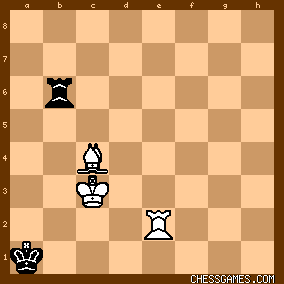
click for larger view<160.?> |
|
| May-27-16 | | Patriot: I got 135...f3 136.gxf3 Kf1 137.Nf4 Nd4 but wasn't exactly sure what was to happen next. 135...Kf1?? 136.Nxf4 is probably even. |
|
| May-27-16 | | patzer2: In attempting to solve today's Friday puzzle, I got as far as 135..f3 136. gxf3 Kf1 137. Nf4 but then I deviated from 137...Nd4  (#8,
deep Fritz 15) with 137... Nc5 (#8,
deep Fritz 15) with 137... Nc5  (#79, Deep Fritz 15). (#79, Deep Fritz 15).As the Fritz analysis indicates, 137...Nc5 wins but it's less efficient than the game continuation 137...Nd4. For a Black improvement, the computer suggestion 21. g3 = (0.00 @ 31 depth, Komodo 9.3) looks good as 21...Bxd4? fails to 22. Rd1  to to  . After 21. Qa5?! Qb8 . After 21. Qa5?! Qb8  Black has an edge which he slowly but surely increases to a won endgame. Black has an edge which he slowly but surely increases to a won endgame. |
|
| May-27-16 | | YouRang: This one was a bit of a thinker, but I got the gist of it without calculating all the way to the end. Basically, it's about avoiding stalemate and using zugzwang tactics to either promote a pawn or threaten mate. For example, 135...Kf1 is no good (136.Nxf4! since ...Nxf4 is stalemate). So, black first creates a promotion threat with <135...f3>, which leaves white with two reasonable choices: Ng1 or gxf3.
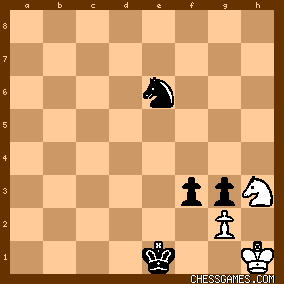
click for larger view~~~~
If <136.Ng1> (IMO the more interesting case), then <136...f2 137.Nf3+ Ke2 138.Nd2!>

click for larger view
The difficulties for black:
- The white N can't be taken (stalemate).
- The black N cannot give check.
- If the white N guards f1, black can't promote.
- Black cannot let white capture Pg3 with check.
However, I think black just has to play ...Nh3! at the right time to take away the stalemate tactic, and then safely promote the pawn or capture the white N. ~~~~
If <136.gxf3>, then the stalemate threat is gone, so <136...Kf1>
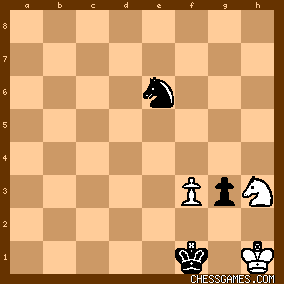
click for larger view
This immobilizes the white K and creates a promotion threat, in addition to creating a mate threat with ...Nf2#. Here, I lazily called it a win, as the N won't be able to stop both threats for long. |
|
| May-27-16 | | dnp: very nice endgame puzzle, as was said before, N endings can be fiendishly difficult. Not for the fainthearted |
|
| May-27-16 | | newzild: <Yourang>
I can see a forced win in your second diagram, after 138. Nd2, viz: 138...Ng5
139. Nf1 Ne4
140. Nd2 f1=Q+!
141. Nxf1 Nf2 mate |
|
| May-27-16 | | gofer: The start is simple...
<135 ... f3>
<136 gxf3 Kf1>
<137 Nf4 ...>
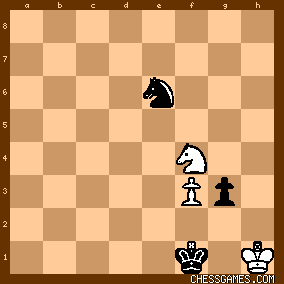
click for larger viewAt this point, the white knight must stop <138 ... g2+> but at the same time the white knight must also try to check the white king, as the white king is on f1, the checks can only come from d2, e3, g3 and h2, but how to do this and cover g2? There is only one way, go to g2! So we know, two moves in advance what is going to happen! So we are actually going to get a free move, so which move to choose!? Well as we <137 ... Ng7/Nd4>
<138 Ng2 Nf5>
The black knight stops any chance of Ne3+ and this also means black has no choice but to go back to f4! <138 Nf4 Nh4>

click for larger viewThe protection of g2 has been lost, white either has to lose its knight or allow the promotion. Game over.
~~~
Okay, <139 ... Nh4> is really bad compared to <139 ... Ne3>. 139 ... Ne3 140 Nh3 Nd1 141 f4 Nf2+ 142 Nxf2 Kxf2 143 f5 g2+ 144 Kh2 g1=Q+ 145 Kh3 Qg3# <139 ... Nh4> still wins, but its a really hard slog in another 20 moves (starting with 140 Nh3 g2+ 141 Kh2 Nxf3+ 142 Kg3 Ng5 143 Nxg5 g1=Q+) |
|
May-27-16
 | | Jimfromprovidence: Great endgame puzzle. Excellent job by <gofer> describing the plan of attack. Just a couple of minor notes.
136...Kf1, below, is the only move that wins.

click for larger viewAfter 139 Nf4, below, black has a forced mate in 8 moves for those inclined to work it out. 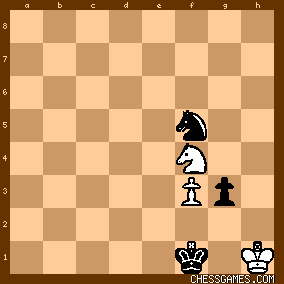
click for larger view |
|
| May-27-16 | | YouRang: <newzild: <Yourang>
I can see a forced win in your second diagram, after 138. Nd2, viz: 138...Ng5
139. Nf1 Ne4
140. Nd2 f1=Q+!
141. Nxf1 Nf2 mate>
Ah, but not mate! <142.Kg1> (legal now since Pf2 is gone). ~~~~
However, in your line, black wins after 139.Nf1

click for larger view
Now, 139...Ke1! (still guards f1, but out of checking range of the N). This sets up a nice knight-sac win if white plays 140.Nd2 (or 140.Ne3): 140...Nh3! destroys the stalemate trap, allowing black to safely promote his pawns (first f, then g). If white opts for 140.Nxg3, then ...Nf4!, attacking the N, and again there's no stopping the pawn from promoting. |
|
| May-27-16 | | kevin86: A very touchy knight ending...with a stalemate trap; black is able to pull it out. |
|
| May-27-16 | | YouRang: Typo in last sentence of my last post. It should say Ne4 instead of Nf4: <If white opts for 140.Nxg3, then ...<Ne4>!, attacking the N, and again there's no stopping the pawn from promoting.> |
|
May-27-16
 | | Fusilli: Most beautiful puzzle in a long time. |
|
| May-27-16 | | agb2002: Black has an extra pawn.
The first idea that comes to mind is 135... f3:
A) 136.gxf3 Kf1
A.1) 137.Nf4 Nd4 (137... Nxf4 stalemate; 137... Ng5 unclear) A.1.a) 138.Ne2 Nxe2 139.f4 g2+ 140.Kh2 g1=Q+ 141.Kh3 Qg3#. A.1.b) 138.Ng2 Nf5 139.f4 (else White loses the knight without stalemate and without winning the g-pawn, protected from f5) 139... Kf2 zugzwang, the white knight is lost: 140.Nh4 Nxh4 141.f4 g2+, etc. A.1.c) 138.Nh3 g2+ 139.Kh2 Nxf3+ 140.Kg3 Ng5 wins.
A.2) 137.f4 g2+ 138.Kh2 Nxf4 139.Ng1 (139.Nxf4 g1=Q+ wins) 139... Kf2 zugzwang (140.Ne2 Nxe2; 140.Nf3 Kxf3; 140.Nh3+ Nxh3). B) 136.Nf4 Nxf4 137.gxf3 g2+ wins. For example, 138.Kh2 Ke2 139.Kg1 Kxf3 140.Kh2 Ne2, etc. C) 136.Ng1 f2 looks winning. For example 137.Nf3+ Ke2 138.Nd2 Nf4 139.Nf1 Ke1 140.Ne3 (140.Nxg3 Ne2 wins) 140... Nh3 141.gxh3 (141.Nc2+ Kd2 142.Ne3 Kxe3 wins) 141... Ke2 142.Kg2 Kxe3 143.Kf1 Kf3 144.h4 g2#. Or 137.Nh3 f1=Q+ 138.Ng1 Qf5 139.Nf3+ Qxf3 10.gxf3 Kf2 and mate in three. |
|
| May-27-16 | | YouRang: <agb2002><C) 136.Ng1 f2 looks winning. For example 137.Nf3+ Ke2 138.Nd2 Nf4 139.Nf1 Ke1 140.Ne3 (140.Nxg3 Ne2 wins) 140... Nh3 141.gxh3 (141.Nc2+ Kd2 142.Ne3 Kxe3 wins) 141... Ke2 142.Kg2 Kxe3 143.Kf1 Kf3 144.h4 g2#. Or 137.Nh3 f1=Q+ 138.Ng1 Qf5 139.Nf3+ Qxf3 10.gxf3 Kf2 and mate in three.> Alternative: after 141.gxh3:
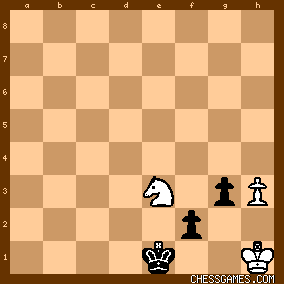
click for larger view
Instead of 141...Ke2, black can promote directly with <141...f1Q+>, and all white moves are absolutely forced: 142.Nxf1 Kxf1 143.h4 g2+ 144.Kh2 g1Q+ 145.Kh3 Qg2# |
|
| May-27-16 | | mel gibson: This is a difficult ending.
Try playing it yourself against your computer.
One wrong move & it ends up a draw or you lose. |
|
| May-28-16 | | RandomVisitor: FinalGen gives
135...f3 136.gxf3 Kf1 137.Nf4 Nd4 138.Ng2 Nf5 139.Nf4 Ne3 140.Ne2 g2+ 141.Kh2 Kxe2 142.Kg1 Kxf3 143.Kh2 Kf2 144.Kh3 g1Q |
|
| May-28-16 | | agb2002: <YouRang> Yes, 141... f1=Q+ is much better. I found this puzzle far more difficult than I expected and needed three attempts along the day to find a more or less complete solution but, according to <Fusilli>, it was a most beautiful puzzle. |
|
May-28-16
 | | Fusilli: <agb2002: <YouRang> ... but, according to <Fusilli>, it was a most beautiful puzzle.> Isn't it? My criteria for beauty is: a) few pieces on the board, b) the maddening aesthetics of knights jumping around, almost dancing with each other, c) the precision involved in making the extra pawn count, and d) the care required to avoid stalemate traps. (BTW, beautiful does not mean I got it... I got it partially, I've become too lazy or too time-constrained to work on the whole thing.) In the variant you and <YouRang> were discussing, 136.Ng1 Ng5 is also winning, and very pleasing (at least to my eyes). 
click for larger view137.gxf3 Kf1 138.f4 Ne4 (threatens mate) 139.Nh3 Nf6! 
click for larger view...Ng4 with the threat of g2 mate is coming. White can resign. And did you see what the black knight did? Ng5-e4-f6-g4... sheer beauty! :) |
|
| May-28-16 | | YouRang: <Fusilli> I liked this puzzle too. I've always been partial to endgame puzzles, especially when they have the deceptive appearance of simplicity, and are yet complicated by the special tactical considerations that often come into endgame play, such as promotion, stalemate, and zugzwang. This puzzle had them all. |
|
May-28-16
 | | Fusilli: Actually, in my previous post, 139...Nf2+ wins too, obviously. |
|
| May-29-16 | | agb2002: <Fusilli>, <YouRang> It seems we share some kind of fascination for endgame studies. |
|
May-30-16
 | | Fusilli: <agb2002: <Fusilli>, <YouRang> It seems we share some kind of fascination for endgame studies.> We do! I think one aesthetic advance of endgame puzzles (which sometimes look indeed like studies) is that every single piece matters or has a purpose for being exactly where they are. In middle game puzzles, there are multiple pieces that don't matter. |
|
 |
|
< Earlier Kibitzing · PAGE 2 OF 2 ·
Later Kibitzing> |
|
|
|





